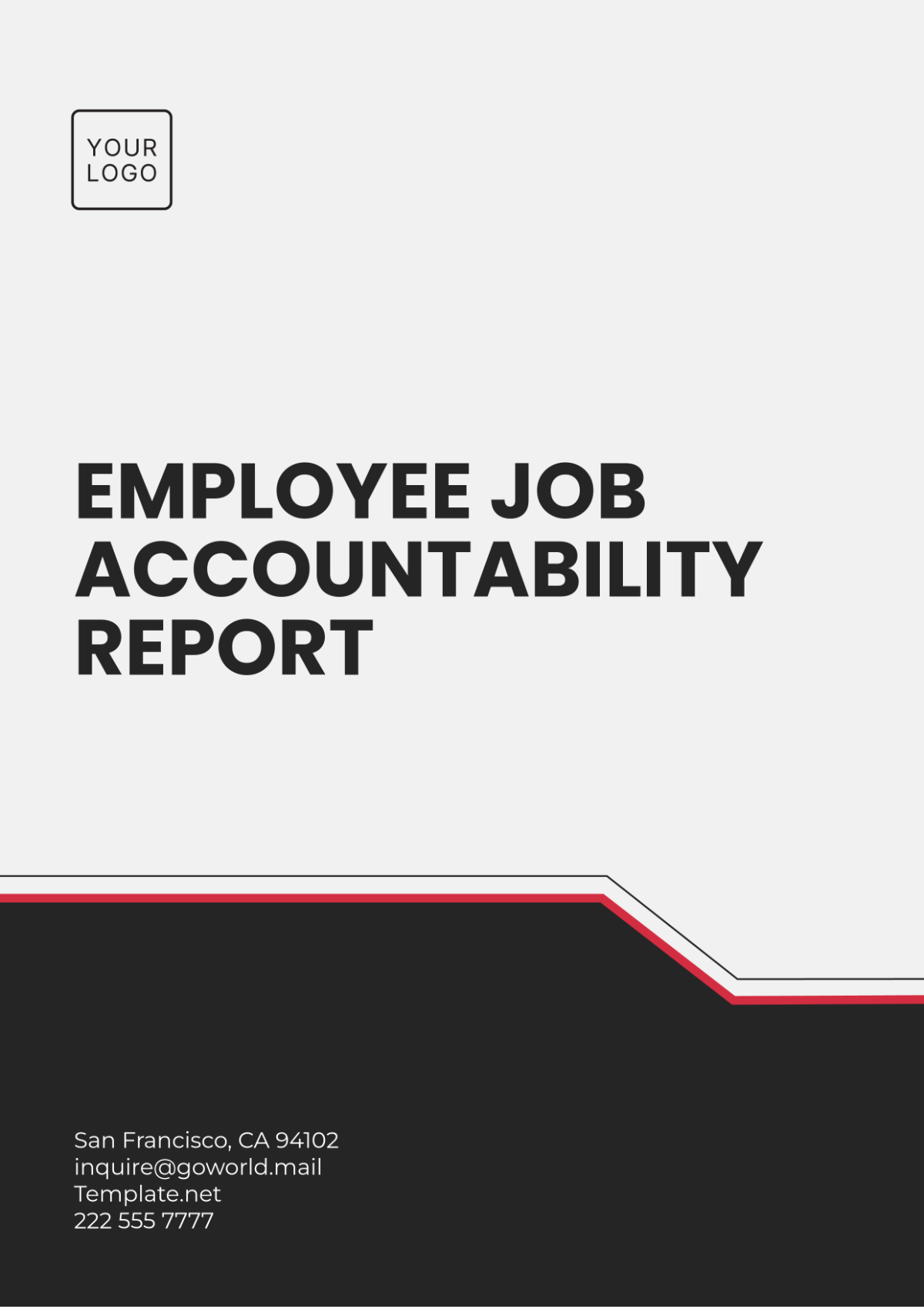Free Employee Job Accountability Report

Employee Name: Emily Carter
Position: Operations Coordinator
Department: Operations
Manager: [Your Name]
Reporting Period: January 1, 2054, to October 31, 2054
1. Summary of Responsibilities
During the reporting period, the employee was responsible for the following key tasks and duties:
Overseeing the daily operations of the department, ensuring all processes run smoothly.
Coordinating schedules and resources for various projects, including ensuring all deadlines were met.
Managing and maintaining departmental records, documentation, and inventory systems.
Communicating with external vendors and suppliers to ensure timely delivery of goods and services.
Assisting with the development and implementation of process improvements to enhance operational efficiency.
These responsibilities contributed to the overall goal of increasing operational efficiency and reducing costs across the department.
2. Performance Review
Key Achievements
Streamlined Scheduling System: Introduced an updated scheduling tool, resulting in fewer scheduling conflicts and faster project turnaround times.
Vendor Relations: Managed vendor contracts effectively, securing cost reductions in supply expenses while maintaining service quality.
Process Improvement: Led the implementation of a new inventory tracking system, improving accuracy and reducing discrepancies.
Areas of Improvement
Communication Efficiency: Although the employee excelled in operational tasks, there were some delays in internal communication, particularly with the team on progress updates for ongoing projects.
Time Management: In certain instances, overlapping responsibilities led to minor delays in task completion, especially during high-priority project periods.
3. Goals & Objectives
Goals for the Reporting Period
Goal 1: Improve the accuracy and efficiency of inventory management by reducing errors.
Goal 2: Enhance the vendor management process by negotiating more cost-effective contracts.
Goal 3: Streamline communication channels within the team for faster decision-making and project completion.
Achievement of Goals
Goal 1: Exceeded expectations by significantly reducing inventory discrepancies, thanks to the new inventory tracking system.
Goal 2: Successfully negotiated better contracts with vendors, resulting in savings for the department.
Goal 3: Improved team communication, although some delays were still observed during periods of heavy workload.
New Goals for the Upcoming Period
Goal 1: Improve communication and information sharing within the team by implementing regular check-ins.
Goal 2: Further optimize project management processes to ensure faster and more efficient turnaround times.
Goal 3: Develop leadership skills by taking on more responsibility in training and mentoring new employees.
4. Key Performance Metrics
Metric | Target/Expected Outcome | Actual Outcome | Comments |
|---|---|---|---|
Inventory Management | Reduce errors by 15% | Reduced by 20% | Exceeded expectations |
Vendor Cost Savings | Save 5% on supplies | Saved 5% | Target met |
Project Turnaround Time | 10% improvement | 8% improvement | Almost met, some delays |
Internal Communication | Reduce delays in updates | 15% reduction | Some delays during busy periods |
5. Feedback from Manager
Positive Feedback
The employee demonstrated strong organizational skills, particularly in managing departmental schedules and vendor relations. Their contributions have led to tangible improvements in operational efficiency, and they are highly regarded for their problem-solving abilities.
Constructive Feedback
The employee would benefit from enhancing time management skills, particularly when juggling multiple tasks. Additionally, improving internal communication during peak times would help ensure smoother project flow and timely completion.
6. Recommendations for Development
To support continued growth and success, the following development actions are recommended:
Training/Skill Development: Enroll in a time management course to help prioritize tasks and improve efficiency during high-pressure periods.
Mentorship/Coaching: Pair with a senior team member to learn strategies for better communication during busy periods and streamline decision-making processes.
Stretch Assignments: Take on additional leadership responsibilities, such as mentoring new team members or managing a small team project, to further develop management skills.
7. Conclusion
The employee has proven to be an essential part of the team, achieving key goals, including improving inventory management and securing cost savings with vendors. While there are areas for improvement, particularly in communication during busy times, their overall performance has been strong. With further development in time management and leadership, the employee is poised to take on even greater responsibilities within the team.
Prepared by:
[Your Name]
Operations Manager
Operations Department
November 5, 2054
- 100% Customizable, free editor
- Access 1 Million+ Templates, photo’s & graphics
- Download or share as a template
- Click and replace photos, graphics, text, backgrounds
- Resize, crop, AI write & more
- Access advanced editor
Enhance employee performance tracking with the Employee Job Accountability Report Template from Template.net. This fully editable and customizable template provides a structured framework for documenting responsibilities, achievements, and areas for improvement. Designed for managers and HR professionals, it allows you to tailor the content to suit specific roles and expectations. Streamline your reporting process, promote accountability, and foster a culture of continuous improvement within your organization with this essential tool.
You may also like
- Employee Letter
- Employee ID Card
- Employee Checklist
- Employee Certificate
- Employee Report
- Employee Training Checklist
- Employee Agreement
- Employee Contract
- Employee Training Plan
- Employee Incident Report
- Employee Survey
- Employee of the Month Certificate
- Employee Development Plan
- Employee Action Plan
- Employee Roadmap
- Employee Poster
- Employee Form
- Employee Engagement Survey





























